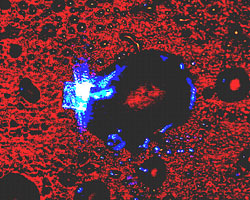A Microscope from Flatland

Biologists dream of a point-and-shoot camera that can reveal details smaller than a wavelength of light in living cells. Now, in the 11 February issue of PRL, researchers show that “two-dimensional” light–short-wavelength light waves that live on a surface–can improve resolution without the expensive equipment and special preparations needed for electron microscopes and other technologies. The team imaged nanoscale holes as a demonstration, but they believe the technique could ultimately take instant shots and even movies of the biological nanoworld.
When light meets a metallic surface it generates waves called surface plasmons, also known as two-dimensional (2D) light, which is made of electromagnetic waves coupled with conducting electrons. Igor Smolyaninov of the University of Maryland in College Park and his colleagues have come up with a way to coax plasmons into magnifying images. They place a microscopic sample onto a thin, metal-coated glass surface, like a document on the surface of a photocopier, and deposit a drop of glycerin on top of it. Next, they shine laser light through the glass, which creates surface plasmons in the metal coating. The plasmons “sense” the sample by scattering off of it. They can sense finer details than ordinary light because their wavelength is only 70 nanometers, seven times shorter than that of the laser.
To concentrate the scattered 2D light, the team uses the curved vertical surface of the glycerin drop where it contacts the metallic plane and reflects plasmons. This surface works a bit like a giant radio telescope dish in reverse: Rather than focusing parallel astronomical light rays to a point, it collects the scattered plasmons emerging from a tiny sample–positioned strategically near the mirror–and redirects them into a plasmon “beam” in the metallic plane. To view the image, the team exploits nanoscale irregularities in the metal surface that scatter some of the light upward, so that an ordinary microscope can catch it. “This is the way a Flatlander would build a microscope,” says Smolyaninov, referring to Edwin Abbott’s 1880 novel Flatland, set in a 2D world inhabited by 2D characters.
To demonstrate their technique, the team shot pictures of metal films carved with grids of nanoscale holes. Although somewhat distorted, the images resolved holes less than 150 nanometers apart, which would be impossible without the plasmons’ help. The team believes the resolution could be pushed to perhaps 10 nanometers.
Currently the researchers must adjust the droplet’s shape “by hand” using micromanipulators, but they hope to replace it with solid mirrors etched on the glass by lithography to make a practical device. A scientist could then buy the special glass slides to use with any microscope. “This would move everybody into the world of electron microscopy for the cost of a regular microscope,” says team member Christopher Davis. Moreover, samples would need no special preparation, as is required for electron microscopy. Movies might be possible, he says, because the image is taken all at once, rather than one pixel at a time, as with near-field optical microscopes that also have high resolution.
Christian Girard of the Center for Material Elaboration and Structural Studies in Toulouse, France, says state-of-the-art lithography cannot yet produce mirrors as smooth as the surface of a droplet, but technology is improving fast. “Perhaps it will be possible in the near future,” he says.
–Davide Castelvecchi
Davide Castelvecchi is a freelance science writer in Rome.


